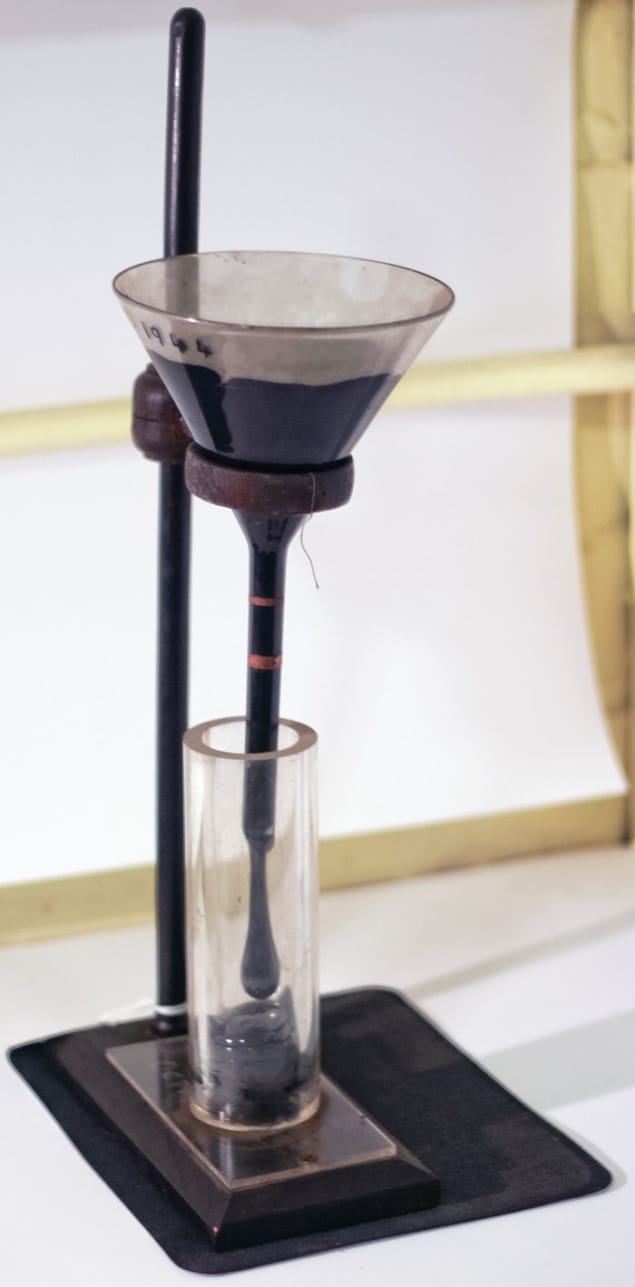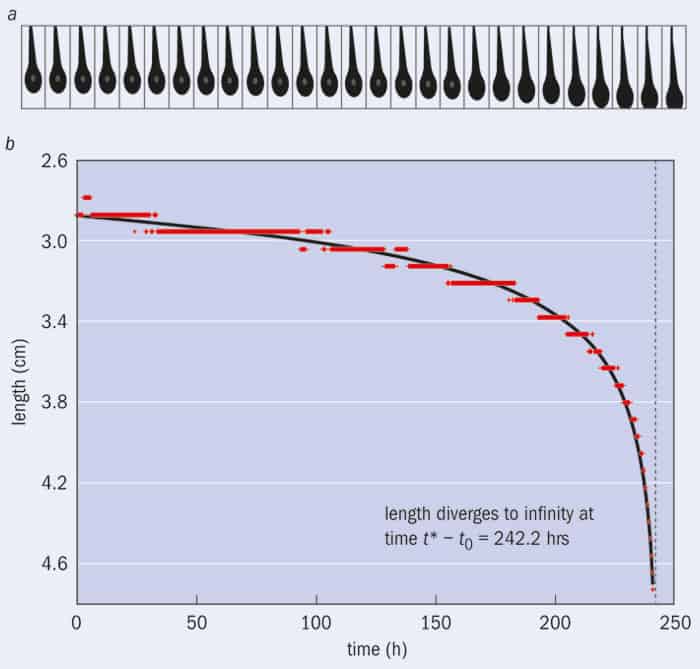When physicists at Trinity College Dublin began looking after an antique funnel full of pitch, they had no idea their humble experiment would spawn one of 2013’s most “viral” news stories. Shane D Bergin, Stefan Hutzler and Denis Weaire reflect on the value of “slow science” to a hyper-connected, social-media world

It has been described as an experiment, but it lacks most of the essentials needed to qualify as such. The material is not well characterized, its environment is poorly controlled and, until recently, it was not even regularly monitored. Nevertheless, in 2013 our observation of a falling drop of pitch attracted more than two million hits on YouTube, was listed in Discover magazine as one of the year’s top 100 science stories and even formed part of an Australian cricket commentator’s Test Match report for The Times.
This apparently mundane event captured the public imagination to an extent that none of us anticipated. It seems that even in the modern world of research, the meek shall sometimes inherit the Earth. But how, exactly, did a funnel full of pitch at Trinity College Dublin become “the drop heard round the world”?
The modern chapter of this story began in the 1980s, when dusty cupboards were emptied of their antique contents in the School of Physics at Trinity. During this clear-out, many strange objects came to light, including a funnel filled with pitch and dated October 1944. Pitch is a black polymeric material. If you hold it in your hand, it feels solid. If you were to hit it with a hammer, it would shatter. However, if left for long (really long) periods of time under the pull of gravity, pitch will flow, like a liquid. And since October 1944 that’s what our experiment had been doing. Indeed, we could see a drop slowly forming at the bottom of the funnel, preparing to join older ones that had evidently detached in earlier times, at a rate of about once per decade (see photo below).
Unfortunately, there was no clue to the identity of the experiment’s creator. In October 1944 Trinity was home to the future physics Nobel laureate Ernest Walton, who loved simple demonstrations, but nobody could remember him talking about this one. But even without a confirmed distinguished progenitor, the funnel still seemed worthy of display, so it survived the cull and was returned to a shelf where it could be observed. Year after year, undergraduate students idled past it, paying no heed to the “slow science” of the pitch drop.
Watching pitch flow

After decades of this benign neglect, our attention was once more drawn to the pitch experiment in November 2000, when news stories emerged that a similar funnel at the University of Queensland, Australia, had just produced a drop (details of the Australian set-up can be found in R Edgeworth et al. 1984 Eur. J. Phys. 5 198). When you consider the time it takes for a drop of pitch to form, the chances of being there to see the drop drip are exceedingly small; despite the age of these experiments, it seemed that nobody had ever witnessed or recorded this momentous event. The Australian drop’s curator, John Mainstone, had intended to remedy this by videoing the drop. Sadly, the camera was not switched on at the crucial moment. Sadder still, Mainstone died in 2013 before he could record the sequel – which, with incredible timing, finally fell as this article was going to press.
Noting the attention that the Australian drop had attracted (which included an Ig Nobel Prize in 2005 “for patiently conducting an experiment that began in the year 1927”), we resolved to set up a camera to monitor the one at Trinity. By the time we did so, our funnel appeared heavily pregnant. Then, in the early hours of 11 July 2013 – perhaps assisted by some exceptionally warm weather – a heavy tear-drop blob of pitch fell to the base of the beaker below, with a thin thread connecting it to the stem of the funnel. The drop had dripped.
A complex drop
Before we discuss the media storm that followed our drop’s fall, let us concentrate for a moment on the physics. In the years before the Second World War, the “pendant drop” was a set-piece of the elementary physics curriculum. Through it, students learned about surface tension, which they measured by finding the critical mass of a drop of water, at which gravity wins out and causes it to fall from a nozzle. The Plateau–Rayleigh instability of a thin column of fluid is implicated in the final breakaway; hence, only in the drop’s ultimate demise does viscosity play much of a role.
When, instead of water, one considers a liquid that is highly viscous (and perhaps viscoelastic), the situation changes. Three forces are now involved at every stage, including viscosity. Compare a dripping tap with honey pouring from a spoon. Not only is the stream of dripping honey much slower to develop, but it eventually forms a long, thin filament, or neck, with the drop acting as a fixed weight, stretching it out. At this stage inertia begins to play a role, with the drop entering a regime of nearly free-fall while still remaining attached to an ever-longer and thinner thread.
However, the ultimate process of detachment for such a drop remains mysterious. It may feature the generation of a cascade of a series of necks of ever-decreasing diameters, with surface tension again playing an important role (as suggested by X D Shi et al. 1994 Science 265 219). As is so often the case in physics, an apparently simple and mundane problem becomes more complex and intriguing the closer you look.
In our pitch drop, the endgame was not visible, as the drop did not entirely detach, being still linked to the stem of the funnel by a thin thread. Given the small size of the apparatus, this was not surprising. Even before the drop dripped, we could see that it was going to touch the pool of pitch below before detaching, and while we had managed to raise the funnel somewhat by carefully loosening rusty screws that were last tightened in October 1944, we were only able to put 5 cm of clearance between the drop and the pool. This proved insufficient. Indeed, in a series of complementary experiments using honey, we found thread-lengths of up to about 12 cm before break-off, and the break-off length is known to increase with viscosity (A Rothert et al. 2005 New J. Phys. 5 59.1).

Nevertheless, we were able to extract useful information by analysing video footage of the final 250 hours of the pendant drop. Data taken from the video images show that the drop’s fall accelerated towards the end, in accord with a formula from Y M Stokes et al. (Quarterly Journal of Mechanics and Applied Mechanics 53 565) that was derived for flow opposed only by viscosity.
Under these circumstances, the length of the drop, L, diverges to infinity at a finite time, t* – t0, according to
where L0 is some effective initial length of the drop at t = –t0, and L1 is an off-set fitting parameter. The crisis time t* (244.5 hours for our pitch drop) is related to the viscosity, µ, density, ρ, and the gravitational constant, g, by t* = 3µ/(ρgL0). The fit shown in figure 1b is consistent with a viscosity of ~2 x 107 Pa·s – not far from that found for our drop’s Australian cousin.
A drop of media gold
Unlike previous Australian drops, the final moments of ours had been caught on camera (see below). Once made available on the World Wide Web, a time-lapse video of the drop’s final days induced the kind of viral explosion of interest that characterizes our age. Perhaps primed by the coverage given to the rival Australian drop in 2000, the world’s media were energized by the uniqueness of this event and keen to report on a short, quirky world-first that resonated with the social-media generation.
Remarkably, within two weeks our video had been viewed more than two million times by people in almost every country in the world. Calls were coming in thick and fast to Trinity from various media giants, including the German publications Die Zeit and Der Spiegel, the Huffington Post, National Geographic and even the Wall Street Journal. Being asked hard questions by the world’s press compelled us to take the thing a little more seriously. So why the worldwide interest?
In January the New Yorker published an article asking why certain online content “goes viral”. What pushes someone to not only read a story but to pass it on? According to the article, a positive outcome, strong narrative and bizarreness are all key ingredients, as is a story’s ability to arouse curiosity. Furthermore, the article argued that readers are drawn to material that creates “social currency” – information that, when we pass it on, allows us to feel smart and be perceived as smart by others. This is a phenomenon that physicists would enjoy analysing (and they probably do), since it is akin to the cascade of photons in lasers or the chain reaction in a nuclear pile.
The Trinity pitch drop seems to tick all of these boxes. It was not a Eureka! moment. We learned nothing we did not know before. However, our Australian colleagues had built up a remarkable tension when extraordinary bad luck saw them miss previous drops falling. (The 2014 Australian drop was caught on camera and a video is available at http://ow.ly/w1k1M.) The human aspect of the story resonated with the public, as evidenced by the extensive media coverage given to Mainstone’s death. It seems that our video brought finality to this scientific saga.
What more can we say of the global interest in our drip? Are there lessons to be learned for science outreach? Perhaps. With astute insight, the New Yorker article warns that the more we mine data on viral content in order to define a “precise calculus” of why people share some things and not others, “the less likely it will be for what we know [about why things ‘go viral’] to remain true. If emotion and arousal are key, then, in a social application of the observer effect, we may be changing what will become popular even as we’re studying it.” It’s almost quantum mechanical!
A legacy of slow science

Our burst of fame was bright, but short-lived: the initial ~105 daily views of the pitch-drop video fell exponentially, with a half-life of 2.5 days. Sic transit gloria mundi. However, our own interest continues. Not long after the flurry of activity generated by the momentous drop, one of us happened to be inspecting old instruments at Aberystwyth University. Hidden among them was yet another pitch-drop experiment, this one begun in 1914 by G T R “Taffy” Evans, who subsequently emigrated to South Africa. But even if he had stayed he would not have seen much happen: current estimates suggest that it will take at least 1000 years for the pitch to emerge from the funnel, let alone form a drop. This confirms that pitch is a poorly defined substance, of variable properties (see photograph left).
Back in Dublin, we now intend to set up a larger version of the funnel apparatus, one that may enable us to see the stretching of a viscous filament to a much greater length, and perhaps its eventual dénouement. If pitch is used, the experiment will require great patience, but perhaps, as Milton put it, “they also serve who only stand and wait”. Indeed, we have an excellent example of this in Lord Kelvin, whose experiments in “slow science” are still cherished today, a century after his death. Among them was a ramp down which pitch flowed, rather in the manner of a glacier. His interest in pitch was part of a wider search for a substance that might mimic the properties of the aether of space, which he considered (at various times) to be analogous to a jelly, a foam or a network of fluid vortices. During Kelvin’s fruitless search for a better aether model, he placed some of the first footprints in modern materials science.
The pace of data-gathering and publication is not hectic, but slow science provides good food for thought in tranquilitude.



